
Aug . 14, 2024 07:20 Back to list
Exploring the Aesthetic and Functional Qualities of Traditional Roman Style Roof Tiles in Architecture
The Elegance and Functionality of Roman Style Roof Tiles
When considering roofing options that combine aesthetic appeal, durability, and cultural significance, Roman style roof tiles stand out prominently. These distinctive tiles, often associated with classical architecture, have adorned structures for centuries and continue to influence contemporary design. This article explores the unique characteristics, historical significance, and modern application of Roman style roof tiles.
Characteristics of Roman Style Roof Tiles
Roman style roof tiles, traditionally made from fired clay, are renowned for their unique shape and functional design. The most iconic variants include the Roman or S tile, characterized by its wavy profile that allows for interlocking placement. This interlocking mechanism not only enhances the roof's stability but also contributes to its remarkable resistance to adverse weather conditions. Unlike flat tiles, the curvilinear shapes of Roman tiles facilitate efficient water drainage, a crucial feature in regions prone to heavy rainfall.
The rich, terracotta color of these tiles adds a warmth and charm that can transform the aesthetic of any building. While classic red remains a popular choice, modern variations offer a spectrum of colors and finishes, allowing homeowners and architects to customize their roofs to match specific design preferences. Additionally, the matte finish typical of clay tiles provides a timeless look, avoiding the glossiness of less traditional materials.
Historical Significance
The use of Roman tiles dates back to ancient Rome, where they were employed in the construction of temples, villas, and public buildings. The Romans perfected the art of tile-making, combining functionality with beauty. This architectural tradition enabled roofs to withstand the test of time while maintaining an elegant aesthetic. As the Roman Empire expanded, so too did the influence of Roman tiles, spreading throughout Europe and beyond.
roman style roof tiles

During the Renaissance, the revival of classical styles ignited renewed interest in Roman architecture, leading to the revitalization of these tiles in European construction. Today, the legacy of Roman tiles is evident in many historical buildings and enduring architectural styles, symbolizing a connection to our past while anchoring us in contemporary life.
Modern Applications
In today's architectural landscape, Roman style roof tiles remain a popular choice for new constructions, renovations, and restorations. Their enduring appeal lies not only in their aesthetic virtues but also in their sustainability. Clay tiles are made from natural materials and, when sourced responsibly, pose a minimal environmental impact. Moreover, they are energy-efficient, helping to regulate indoor temperatures and reduce heating and cooling costs.
Architects and builders are increasingly embracing Roman tiles for both residential and commercial projects. They are particularly favored in Mediterranean-style homes, where they enhance the character and authenticity of the design. However, their versatility allows them to be incorporated into various architectural styles, from rustic to modern minimalism, making them a go-to choice for many.
Furthermore, advancements in manufacturing processes have led to the development of lightweight alternatives to traditional clay tiles, enabling easier installation while maintaining the classic aesthetic. These innovations widen the accessibility of Roman style roof tiles, encouraging even more widespread use.
Conclusion
Roman style roof tiles are a testament to the harmonious blend of beauty, functionality, and historical significance. Their distinctive shape, durable nature, and rich heritage have established them as a favored choice for many architects and homeowners. As we look to the future, the continued popularity of Roman style roof tiles speaks volumes about our appreciation for classic design and sustainable building practices. Whether adorning a new home or restoring a historical structure, these tiles not only protect but also enhance the architectural narrative of our built environment.
-
Moonlight White HIREFLE Granules with GPT-4 Turbo
NewsAug.02,2025
-
Premium Round Asphalt Shingles: Durable & Elegant Roofing
NewsAug.01,2025
-
Eco-Friendly Clay Tiles | AI-Enhanced Durability
NewsJul.31,2025
-
Durable Shingle Granules for Premium Roofs
NewsJul.31,2025
-
Stone Coated Metal Roof Tile-Roman Tile for Durable Roofing Solutions
NewsJul.30,2025
-
Stone Coated Metal Roof Tile-Wood Grain Tile for Durable Roofing
NewsJul.30,2025







